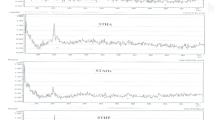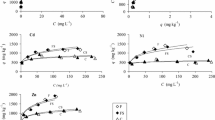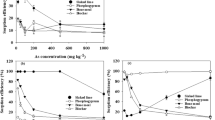Abstract
Measurements were made of the adsorption of lead, cadmium, zinc, nickel and uranium per unit surface area of microorganisms, two clays (reference smectite, kaolinite), and two soils (untreated Vertisol and treated Vertisol) to quantify the selective affinity. The adsorption of heavy metals and uranium by the samples was influenced by soil constituents, and increased with increasing Pb, Ni, Zn, Cd and U concentrations. Microorganisms were also compared with these abiotic soil constituents for their ability to adsorb these metals. Dead cells adsorbed the largest quantity of all heavy metals than live cells and other soil components. At pH 6.0, the uptake percentage of U(VI) by dead cells was higher than that of any of the other metal ions. On the basis of amounts of adsorption on adsorbents, the selectivity sequences were varied. The most common sequences were U≫Pb>Cd≈Zn>Ni. The results verified the importance of geochemical parameters of soils such as type of clay mineral, oxide mineral content, and organic content, for controlling metal uptake. The results also suggest that bacterial membrane cells can be successfully used in the treatment of mixed metal-contaminated wastes.
Similar content being viewed by others
References
Allison, J.D., Brown, D.S. and Novo-Gradac, K.J., 1990, MINTEQA2/PRODEFA2, A geochemical assessment model for environmental systems: version 3.0 user's manual. Environmental Research Laboratory, Office of Research and Development, U.S. Environmental Protection Agency, Athens, Georgia, 106 p.
Aranfalk, P., Wasay, S.A. and Tokunaga, S., 1996, A comparative study of Cd, Cr(III), Cr(IV), Hg, and Pb uptake by minerals and soil materials. Water, Air & Soil Pollution, 87, 131–148.
Bargar, J.R., John, R., Reitmeyer, R., Lenhart, J.J. and Davis, J.A., 2000, Characterization of U(VI)-carbonato ternary complexes on hematite: EXAFS and electrophoretic mobility measurements. Geochimica et Cosmochimica Acta, 64, 2737–2749.
Beveridge, T.J. and Doyle, R.J., 1989, Metal Ions and Bacteria. John Wiley & Sons, Inc., New York, 339 p.
Bollag, J. and Duszota, M., 1984, Effect of the physiological state of microbial cells on cadmium sorption. Archives of Environmental Contamination and Toxicology, 13, 265–270.
Carter, D.L., Heilman, M.D. and Gonzalez, C.L., 1965, Ethylene glycol monoethyl ether for determining surface area of silicate minerals. Soil Science, 100, 356–360.
Chao, T.T., 1972, Selective dissolution of manganese oxides from soils and sediments with acidified hydroxylamine hydrochloride. Soil Science Society of America Journal, 36, 764–768.
Davis, J.A., Waite, T.D. and Payne, T.E., 2001, Surface Complexation Modeling of Uranium(VI) Adsorption on ferihydrite, In: Surface Complexation Modelling of Uranium (VI) Adsorption on Natural mineral Assemblages, United States Nuclear Regulatory Commission Report No. NUREG/CR-6708, p. 143–144.
Dixon, J.D. and White, G.N., 1997, Soil Mineralogy Laboratory Manual. Published by the authors. Dept. Soil and Crop Science, Texas A&M University, College Station, Texas.
El-Sheckh, M.M., El-Shouny, W.A., Osman, M.E.H. and El-Gammal, E.W.E., 2005, Growth and heavy metals removal efficiency ofNostoc muscorum andAnabaena subcylindrica in sewage and industrial wastewater effluents. Environmental Toxicology and Pharmacology, 19, 357–365.
Environmental Protection Agency, 1992, Technical resource document: Batch-type Procedures for Estimating Soil Adsorption of Chemicals. Office of Solid Waste and Emergency Response, U.S. Environmental Protection Agency, Report EPA/530-SW-87-006-F, 525 p.
Ernst, W.H., 1996, Bioavailability of heavy metals and decontamination of soils by plants. Applied Geochemistry, 11, 163–167.
Evans, R.C., 1966, An Introduction to Crystal Chemistry, Cambridge University Press, London, 410 p.
Fuller, C.C., Bargar, J.R., Davis, J.A. and Piana, M.J., 2002, Mechanisms of uranium interactions with hydroxyapatite: Implications for groundwater remediation. Environmental Science & Technology, 36, 158–165.
Gomes, P.C., Fontes, M.P.F., Silva, A.G., Mendonça, E.S. and Netto, A.R., 2001, Selectivity sequence and competitive adsorption of heavy metals by Brazilian soils. Soil Science Society of America Journal, 65, 1115–1121.
Greweling, T. and Peech, M., 1960, Chemical Soil Tests. Cornell University, Agriculture Experiment Standard Bulletin, No. 960.
Kurek, E., Czaban, J. and Bollag, J., 1982, Sorption of cadmium by microorganisms in competition with other soil constituents. Journal of Applied Microbiology, 43, 1011–1015.
Ledin, M., Pederson, K. and Allard, B., 1997, Effects of pH and ionic strength on the adsorption of Cs, Sr, Eu, Zn, Cd and Hg byPseudomonas putida. Water, Air, & Soil, Pollution, 93, 367–381.
Lion, L.W., Altmann, R.S. and Leckie, J.O., 1982, Trace-metal adsorption characteristics of estuarine particulate matter: Evaluation of Fe/Mn oxide and organic surface coatings. Environmental Science & Technology, 16, 660–666.
Lovley, D.R. and Coates, J.D., 1997, Bioremediation of metal contamination. Current Opinion in Biotechnology, 8, 285–289.
Lovley, D.R. and Phillips, E.J.P., 1992, Bioremediation of uranium contamination with enzymatic uranium reduction. Environmental Science & Technology, 26, 2228–2234.
Luoma, S.N. and Bryan, G.W., 1981, A statiscal assessment of the form of trace metals in oxidized estuarine sediments employing chemical extractants. Science of The Total Environment, 17, 165–196.
McBride, M.B., 1994, Environmental Chemistry of Soils. Oxford University Press, New York, 406 p.
McCullough, J., Hazen, T.C., Benson, S.M., Metting, F.B. and Palmisano, A.C., 1999, Bioremediation of Metals and Radionuclides... What It Is and How It Works. A NABIR Primer, U.S. Department of Energy, LBNL-42595, Lawrence Berkeley National Laboratory, Berkeley, CA, 58 p.
Mchra, O.P. and Jackson, M.L., 1960, Iron oxide removal from soils and clays by a dithionite-citrate system buffered with sodium bicarbonate. Clays and Clay Minerals, 7, 317–327.
Moore, J.W., 1990, Inorganic Contaminants of Surface Water, Research and Monitoring Priorities. Springer-Verlag, New York, 334 p.
Morris, D.E., Chisholm-Brause, C.J., Barr, M.E., Conradson, S.D. and Eller, P.G., 1994, Optical spectroscopic studies of the sorption of UO2 2 species on a reference smeetite. Geochimica et Cosmochimica Acta, 58, 3613–3623.
O'Day, P.A., Carroll, S.A. and Waychunas, G.A., 1998, Rock-water interactions controlling zinc, cadmium, and lead concentrations in surface waters and sediments, U.S. tri-state mining district: I. Molecular identification using x-ray absorption spectroscopy. Environmental Science & Technology, 32, 943–955.
Pickering, W., 1980, Part I Ecological Cycling. In: Nriagu, J.O. (ed.), Cadmium in the Environment, John Wiley, New York, p. 365–367.
Phillips, E.J.P., Landa, E.R. and Lovley, D.R., 1995, Remediation of uranium contaminated soils with bicarbonate extraction and microbial U(VI) reduction. Journal of Industry Microbiology, 14, 203–207.
Puls, R.W. and Bohn, H.L., 1988, Sorption of cadmium nickel, and zine by kaolinite and montmorillonite suspentions. Soil Science Society of America Journal, 52, 1289–1292.
Sposito, G., 1989, The Chemistry of Soils. Oxford University Press, New York, 277 p.
Schwertmann, U. and Taylor, R.M., 1989, Iron oxides. In: Dixon, J.B. and Weed, S.B. (eds.), Minerals in soil environments, ASA and SSSA, Madison, WI, p. 379–438.
Sylwester, E.R., Hudson, E.A. and Allen, P.G., 2000, The structure of uranium (VI) sorption complexes on silica, alumina, and montmorillonite. Geochimica et Cosmochimica Acta, 64, 2431–2438.
Tessier, A., Rapin, F. and Carignan, R., 1985, Trace metals in oxic lake sediments: Possible adsorption onto iron oxyhydroxides. Geochimica et Cosmochimica Acta, 49, 183–194.
Zachara, J.M. and Smith, S.C., 1994, Edge complexation reactions of cadmium on specimen and soil-derived smeetite. Soil Science Society of America Journal, 58, 762–769.
Author information
Authors and Affiliations
Corresponding author
Rights and permissions
About this article
Cite this article
Choi, J., Park, JW. Competitive adsorption of heavy metals and uranium on soil constituents and microorganism. Geosci J 9, 53–61 (2005). https://doi.org/10.1007/BF02910554
Received:
Accepted:
Issue Date:
DOI: https://doi.org/10.1007/BF02910554




